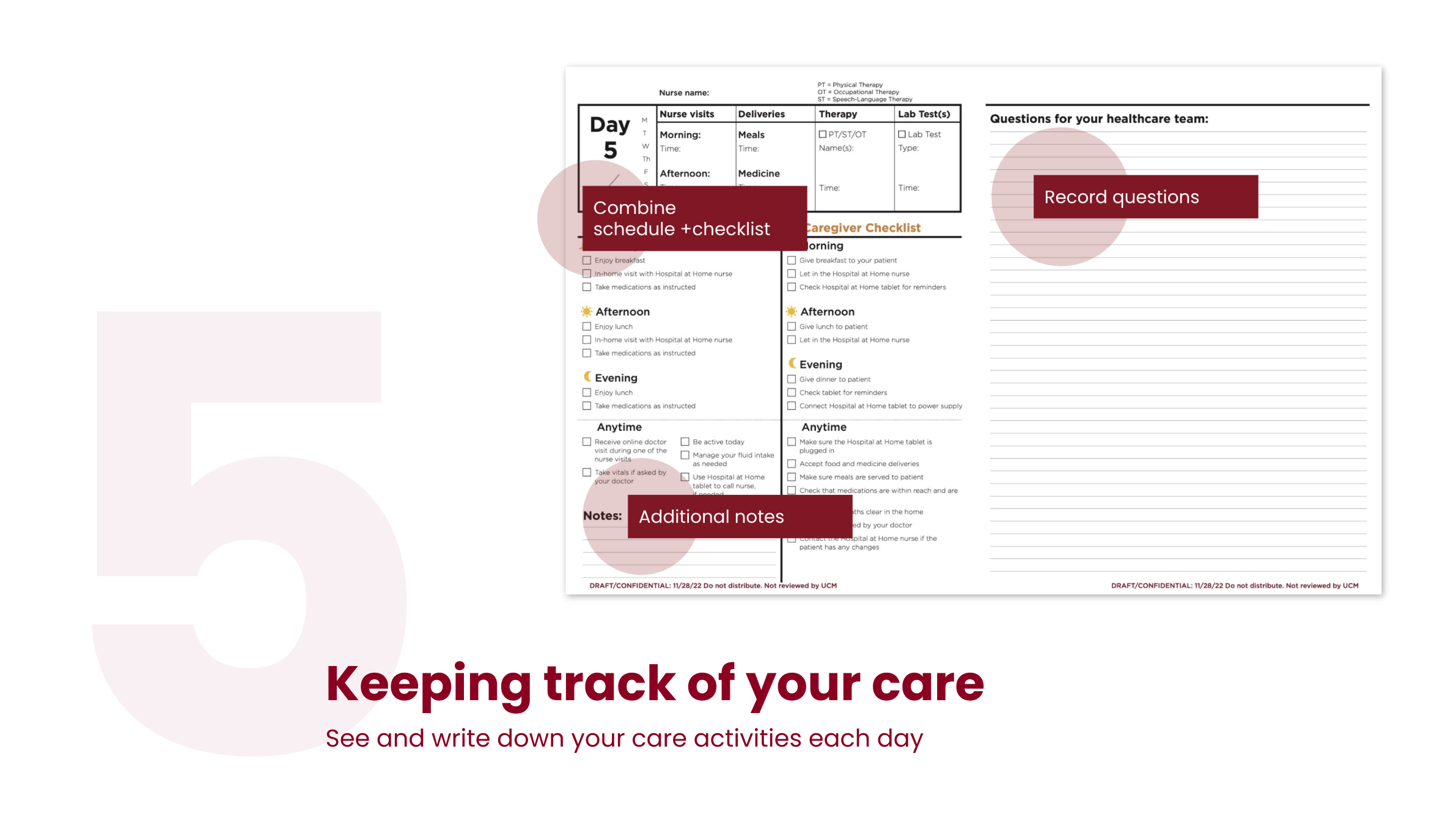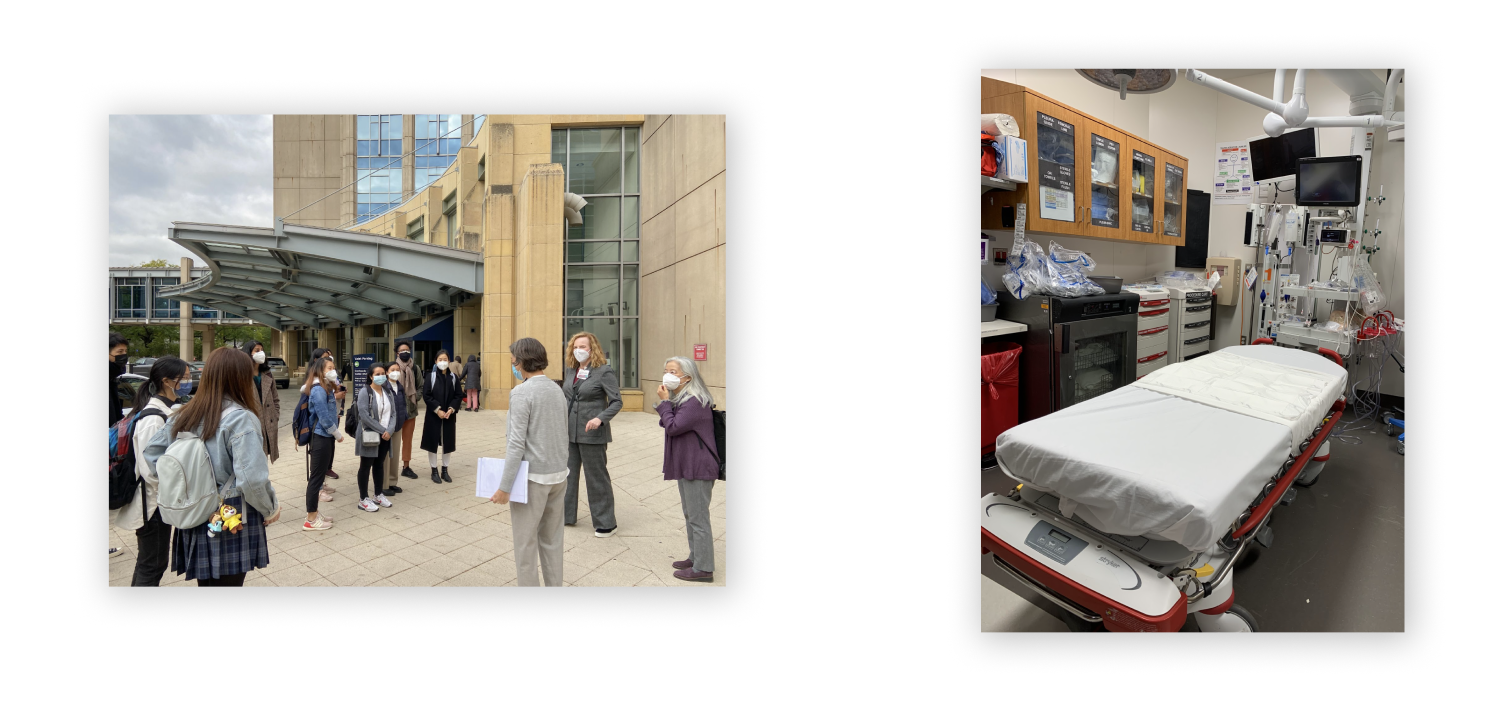INTRODUCTION
University of Chicago Medical Center is scheduled to roll out a new type of healthcare delivery mechanism called Hospital at Home in January 2023, with the first pilot in November 2022. UCMC is partnering with the Institute of Design to explore the communication opportunities such a new experience would offer to patients and caregivers.
MY ROLE
SMEs Interview, Research Synthesis, Information Design, Prototyping
Co-design Workshop Facilitation
TOOLS
Mural, Adobe Creative Suites, G-Suite
THE TEAM
14 designers from Communication Design Workshop Fall 2022,
Professor Tomoko Ichikawa and Kim Erwin
TIMELINE
August - December 2022
THE PROBLEM
Zoe finds it difficult to choose whether to proceed or not with the Hospital at Home program due to lack of understanding and confusing information.
AGE:
LOCATION:
STATUS:
HEALTH CONDITION:
PRIOR SITUATION:
Englewood, south side of Chicago
Living alone
Congestive Heart Failure and has been having a hard time breathing
spent more than 12 hours in the ER waiting for a bed at Mitchell Hospital, which made her feel annoyed and uncomfortable.
67
THE SOLUTION
Understanding the context
PRIMARY RESEARCH
Questions we asked during the interview:
How is a HAH Triage Nurse different than an ED Triage Nurse?
How long are patients given to decide to participate?
What happens if a patient does not have a caregiver?
What are the role and responsibilities of a caregiver?
How long does the prep for transition home take?
How is the home care plan being communicated?
How do patients learn how to use the technology (ie. tablets/iPad)?
What can the patients do if there is a problem or issue arises when they are at home?
GLOSSARY REPOSITORY
Making sure we understand and use the same language as the University of Chicago Medicine
ON-SITE UCHICAGO MEDICAL FACILITIES VISIT
Experiencing what is it like from the journey when the patient was sent to the ER to when they are recovering from at the hospital bed.
The Approach
ANALYSIS OF PRIMARY RESEARCH
To gain a better understanding of the Journey Map, we divided the experience into three main categories:
Introduction + Orientation
Prepare + Transfer
Enactment
Introduction + Orientation
The moment when the patient and the caregiver first get exposed to information about the Hospital at Home program.
Enactment
The moment when the patient and the caregiver are receiving treatment and care from the University of Chicago Medicine Hospital at Home program.
SECONDARY RESEARCH ON PATIENT EDUCATION MATERIALS AND ASSESSMENT TOOL
Information and content placed in any type of medium in the healthcare environment play an important role for the patient and the caregiver to ensure they find, understand and use information and services to inform health-related decisions and actions for themselves and others.
objectively assess the suitability of health information materials for a particular audience in a short time.
SAM
evaluate and compare the understandability and actionability of patient education materials.
PEMAT
Summary of Health Literacy Requirements
Suitability
Including images that are more inclusive
Understandability and Actionability
Adding appropriate visual cues for important info
Readability
Making sure the Flesch-Kincaid Grade Level is below 6
Coming up with possibilities
SCENARIOS
TIME POINT 6.6
When the patient and caregiver receive the
Hospital at Home health monitoring kit
TIME POINT 6.7
When the nurse navigator reviews the roles and responsibilities of the caregiver and the home care plan for the patient
PROTOTYPES
There is a total of 6 different prototypes ranging from video to brochures and booklets. The class is then divided into 6 teams to work on the prototypes.
Program Overview Video
Overview of Hospital at Home Pamphlet
Everything you need to know about Hospital at Home
Escalation Document
HRS Tech Pack
Caregiver Scheduling Booklet & Daily Checklist
Rethinking the content
Goal: To determine whether the content provided is important and makes sense to the participants
CO-DESIGN WORKSHOP
Card Sorting
rank each card into 0: I don't care, 1: I care somewhat, and 2: I care a lot.
Open response
write down what kind of questions should the tablet ask when using it at home.
ANALYSIS
Key Learnings from the workshop
Based on the card sorting result, the majority of the participants think the following content is most relevant.
Hospital at Home nurses are specially trained to give hospital-quality care in the home
Hospital at Home is for people who have a family member that can help each day
Reviewing the materials
PATIENT PANEL
Real-time Feedback from the patients at the University of Chicago Medicine Hospital
Select a more diverse set of images
Prefer watching the video before looking at the pamphlet
Prefer line art compared to photos
Suggestions from the legal and health literacy team at the University of Chicago Medicine Hospital
Add fluid intake information as one of the daily task
Remove repetitive content
Add visuals for preventing falls at home section
STAKEHOLDER REVIEW
The Impact
USABILITY TESTING
Testing the overall program experience with a real patient in the form of Day in a Life documentation to identify additional gaps and needs
University of Chicago Medicine’s Community Health Workers are able to do a test run using
the tablet and other devices while following the instructions from the health monitoring kit that
we developed.
LESSON LEARNED
Challenges we face
Not enough time to make iterations within the team
Decisions from stakeholders can be unknown and uncertain
Clear communication and delegated tasks to work more effectively and efficiently
Learned how to work in adaptable manner as changes approach
Afraid of making mistakes and having to start everything over
Actions we took
Changed the mindset to fail faster and get feedback sooner











































